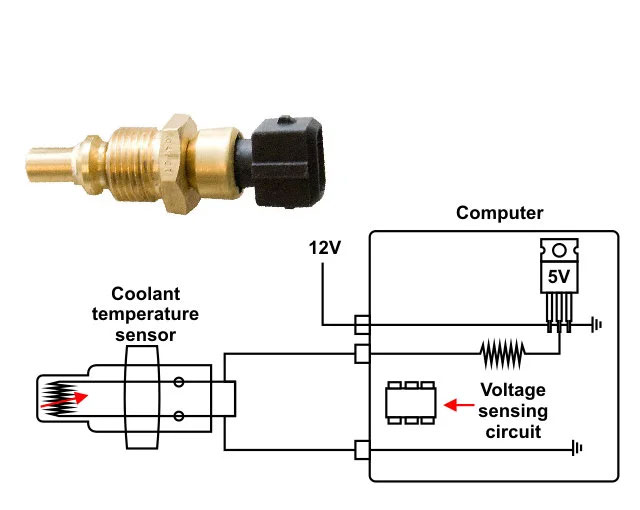
ANALYSIS ON THE ROLE OF ENGINE COOLANT TEMPERATURE SENSOR IN GASOLINE ENGINE
A gasoline motor engine using electronic control system has several sensors and actuators driven by a computer. This paper aims to reveal the role of an engine temperature sensor mounted on a gasoline engine motor. The testing data shows that there is a connectivity between the temperature data obtained from the coolant temperature sensor with the fuel injection time and the exhaust gas emission content.
1. Introduction
- Importance of Sensor Performance Analysis in Vehicles
- Brief Overview of Engine Coolant Temperature Sensor
2. Understanding Sensor Performance Analysis
- Definition and Purpose
- Significance in Vehicle Maintenance
3. Key Components of Engine Coolant Temperature Sensor
- Thermistor Functionality
- Role in Engine Control Unit (ECU)
4. Injection Time and Its Connection to Sensor Performance
- Influence of Coolant Temperature on Injection Time
- Optimizing Engine Performance through Sensor Analysis
5. The Impact of Sensor Performance on Vehicle Operation
- Effects on Fuel Efficiency
- Relationship with Exhaust Emissions
6. Common Issues and Troubleshooting
- Overheating Problems
- Faulty Readings and Diagnostics
7. Benefits of Regular Sensor Performance Analysis
- Prolonged Vehicle Lifespan
- Enhanced Fuel Economy
- Environmental Impact
8. Methods for Sensor Performance Testing
- Using OBD-II Scanners
- DIY Techniques for Basic Analysis
9. Expert Opinions and Insights
- Perspectives from Automotive Engineers
- Importance in Modern Engine Management
10. Case Studies: Real-Life Examples
- Successful Resolutions through Sensor Analysis
- Highlighting the Impact on Vehicle Performance
11. Future Trends in Sensor Technology
- Advancements in Engine Sensors
- Integration of Smart Sensor Systems
12. Challenges in Sensor Performance Analysis
- Evolving Automotive Technologies
- Compatibility Issues and Solutions
13. User-Friendly Tools and Apps for Sensor Monitoring
- Accessibility for Vehicle Owners
- Simplifying Sensor Analysis
14. Conclusion
- Recap of the Importance of Sensor Performance Analysis
15. FAQs
- Addressing Common Queries on Sensor Performance Analysis


Introduction:
The efficiency and performance of vehicles are intrinsically linked to the health of various sensors, and one such crucial component is the Engine Coolant Temperature Sensor. In this article, we will delve into the realm of Sensor Performance Analysis, focusing on its significance, key components, impact on injection time, and its vital role in vehicle operations.
Understanding Sensor Performance Analysis:
Sensor Performance Analysis is the process of evaluating the functionality and accuracy of sensors within a vehicle's engine system. This analysis is paramount for maintaining optimal performance, ensuring fuel efficiency, and minimizing environmental impact.

Key Components of Engine Coolant Temperature Sensor:
At the core of Sensor Performance Analysis lies the Engine Coolant Temperature Sensor. This component primarily utilizes a thermistor to measure the temperature of the engine coolant. This data is then relayed to the Engine Control Unit (ECU), influencing various aspects of the vehicle's operation.
Injection Time and Its Connection to Sensor Performance:
The duration for which the fuel injectors stay open, known as injection time, is directly affected by the engine coolant temperature. Understanding this connection is crucial for fine-tuning the engine's performance and achieving optimal fuel-air mixture ratios.
The Impact of Sensor Performance on Vehicle Operation:
A well-functioning Engine Coolant Temperature Sensor significantly contributes to fuel efficiency, prolonging the engine's life and reducing harmful exhaust emissions. We will explore how sensor performance directly influences these aspects of vehicle operation.
Common Issues and Troubleshooting:
Explore common problems associated with Engine Coolant Temperature Sensors, such as overheating issues and faulty readings. Learn effective troubleshooting methods to diagnose and resolve these issues, ensuring the sensor operates at its full potential.
Benefits of Regular Sensor Performance Analysis:
Regular analysis of sensor performance goes beyond troubleshooting. It offers benefits like prolonged vehicle lifespan, enhanced fuel economy, and a positive impact on the environment. Discover how this proactive approach can revolutionize vehicle maintenance.
Methods for Sensor Performance Testing:
Learn about practical methods for testing sensor performance, including the use of OBD-II scanners and accessible do-it-yourself techniques. These approaches empower vehicle owners to conduct basic sensor analyses, promoting regular maintenance.
Expert Opinions and Insights:
Gain insights from automotive engineers on the critical role of sensor performance analysis in modern engine management. Understand how experts perceive its importance and its evolution in response to advancing automotive technologies.
Case Studies: Real-Life Examples:
Explore real-life examples where successful resolutions were achieved through thorough sensor performance analysis. Highlight the direct impact on vehicle performance and the positive outcomes of addressing sensor-related issues.
Future Trends in Sensor Technology:
Look into the future of sensor technology, examining advancements in engine sensors and the integration of smart sensor systems. Understand how these innovations will shape the landscape of Sensor Performance Analysis.
Challenges in Sensor Performance Analysis:
As automotive technologies evolve, new challenges emerge. Examine the compatibility issues associated with sensor analysis and discover effective solutions to ensure seamless integration.
User-Friendly Tools and Apps for Sensor Monitoring:
Explore user-friendly tools and applications designed for sensor monitoring, making the analysis accessible for vehicle owners. Learn how these tools simplify the sensor analysis process, fostering a user-friendly approach.
Conclusion:
In conclusion, Sensor Performance Analysis emerges as a cornerstone in maintaining and optimizing vehicle functionality. Its influence on fuel efficiency, engine lifespan, and environmental impact underscores its significance in contemporary automotive maintenance.
FAQs:
1. How often should I conduct Sensor Performance Analysis on my vehicle?
- Regular analysis is recommended, ideally during routine maintenance checks.
2. Can I perform basic sensor analysis without professional help?
- Yes, using OBD-II scanners or user-friendly apps simplifies the process for vehicle owners.
3. What are the signs of a malfunctioning Engine Coolant Temperature Sensor?
- Symptoms may include erratic temperature readings, engine overheating, or issues with fuel efficiency.
4. Are advancements in sensor technology compatible with older vehicle models?
- Compatibility may vary, but retrofitting options are available to enhance older vehicles.
5. How does sensor analysis contribute to reducing exhaust emissions?
- Optimizing sensor performance leads to improved combustion, subsequently reducing harmful emissions.


